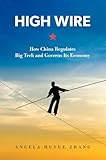High wire : how China regulates big tech and governs its economy / Angela Huyue Zhang.
Publisher: New York, NY : Oxford University Press, [2024]Description: x, 420 pages : illustrations, maps ; 25 cmContent type:- text
- 9780197682258
- 338.951 23/eng/20240422
- HD3616.C63 Z436 2024
| Item type | Current library | Shelving location | Call number | Materials specified | Status | Notes | Barcode | |
|---|---|---|---|---|---|---|---|---|
 BOOKs
BOOKs
|
National Law School | General Stacks | 338.951 ZHA (Browse shelf(Opens below)) | HB | Available | Recommended by Dr. Manpreet Singh Dhillon | 40223 |
Browsing National Law School shelves,Shelving location: General Stacks Close shelf browser (Hides shelf browser)

|

|

|

|

|

|

|
||
| 338.927 AGY Introducing just sustainabilities : policy, planning, and practice / | 338.927 SAC The age of sustainable development | 338.951 ANG How China escaped the poverty trap / | 338.951 ZHA High wire : how China regulates big tech and governs its economy / | 338.954 BAG Colonialism and Indian Economy / | 338.954 BAL India's economy from Nehru to Modi : a brief history / | 338.954 BAR The Bombay plan : blueprint for economic resurgence / |
Includes bibliographical references (pages 293-407) and index.
Introduction;
PART I. ANALYTICAL FRAMEWORK:
1. Hierarchy;
2. Volatility;
3. Fragility;
PART II. PLATFORM REGULATION:
4. Antitrust Regulation;
5. Data Regulation;
6. Labor Regulation;
PART III. PLATFORM SELF- REGULATION:
7. Platforms as Quasi-Regulators;
8. Decentralizing Platform Governance;
PART IV. THE PATH FORWARD:
9. Is China Exceptional?;
10. Assessing the Impact;
11. Regulating Generative AI;
Notes;
Acknowledgments;
Index.
"This book introduces a new analytical framework, the "dynamic pyramid model," to analyze China's unique regulatory model. The model comprises three critical features: hierarchy, volatility, and fragility-depicting the structure, process, and potential outcomes of China's regulatory system respectively. These three features, interconnected through intricate feedback loops, form an extensive network, effectively representing the regulatory dynamics in China. By employing China's tech crackdown between 2020 to 2022 as a comprehensive case study, the book illuminates how the dynamic pyramid model has affected a broad spectrum of legal domains such as antitrust, data, and labor enforcement in China. It further delves into how platforms strategically self-regulate in the shadow of this regulatory system. Meanwhile, comparative exploration of the evolving regulatory landscapes in the United States and the EU demonstrates that China grapples with many similar regulatory issues as its Western counterparts, while also shedding light on the future trajectory of China's legal developments. Furthermore, the book finds that the tech crackdown has resulted in a significant shift in power dynamics between businesses and the Chinese state, leading to the retreat of the private sector and the emergence of the administrative state. The book concludes with some measured predictions of China's future tech governance, focusing on its recent initiative to regulate the rapidly expanding field of generative artificial intelligence"-- Provided by publisher.
There are no comments on this title.
